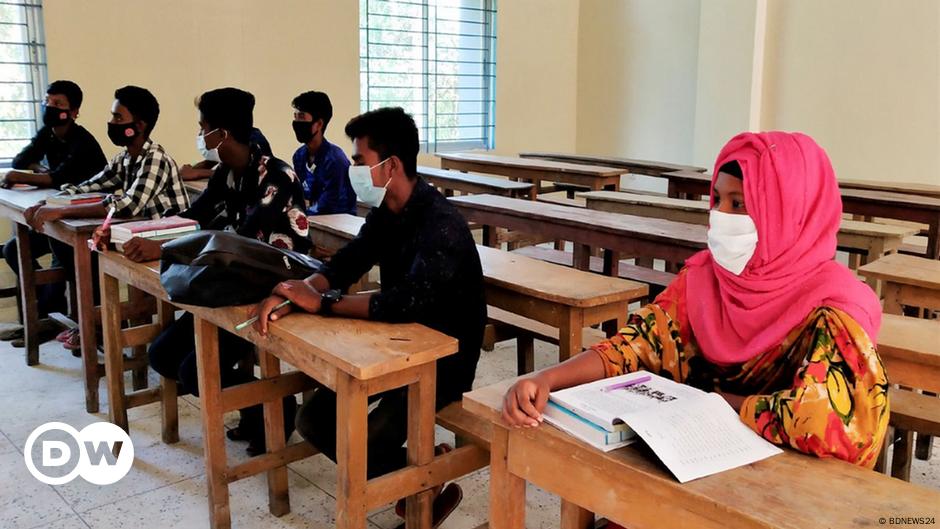Millions of girls in Bangladesh face an uphill struggle to stay in school. For many, the COVID-19 pandemic, natural disasters, and economic hardship have made this struggle even more difficult.
Born in a remote village in the north-eastern region of the country, 19-year-old Zuena is the first person in her family to go to school. They benefited from “boat schools” – classes set up on river boats – which were intended to save children from remote villages from the dangerous journey during the rainy season.
However, during the pandemic, she left secondary school and moved to the capital Dhaka to earn a livelihood.
“My father never told me to stop going to school. I was studying in a boat school [run] The study was conducted by an NGO and for free. But I could not buy pen and paper to study,” said Zuena. “Also, there are no higher secondary schools and colleges in my village. The transportation cost is 40 cents a day, which my father cannot afford,” he added.
School ends with ‘nothing but debt’
In addition to those expenses, Zuena says natural disasters and climate change have also disrupted her education.
“I come from a flood-affected area,” she told DW. “If it rains too much in India we get floods which get worse with time. We are left with nothing but debts which we have to repay.”
Zuena’s father is an agricultural laborer and does not own any land. Dreaming of breaking the cycle of poverty, he sent all but one of his children to school. But it was not just Juana who stopped her education. His two sisters dropped out after completing primary school.
His family moved to Dhaka with Zuena and are now working in the country’s vast, albeit low-paid and regulated, textile production sector.
Experts see ‘huge demand’ for education
The stories of Zuena and her family are very common in Bangladesh. Official figures show that about 8.8 million girls attended primary school at all levels in 2018. But comparing that number to the number of girls enrolled in secondary schools in 2023 shows that about 3.3 million discontinued their education between those years. Even after adjusting this figure for girls attending madrassas (Islamic schools) and vocational schools, the school dropout rate remains over 35%.
This worrying trend continues even though many poor people in Bangladesh understand the benefits of education.
Rasheda K Chaudhary, an educational expert, told DW that there is a “huge demand” for education in the country.
“People who barely survive hand-to-hand believe that education can change their lives. Can we meet their demand for education? Many families are struggling with the cost of secondary education, including tuition, books and transportation. “Can’t afford the associated costs.”
“In rural areas, girls are often taken out to contribute to the household income,” said Chaudhary, executive director of the Campaign for Popular Education (CAMP).
Child marriage perpetuates the cycle of poverty
Other factors keeping children away from schools are that students in remote areas have to contend with poor connectivity and lack of transportation, cultural barriers, and lack of security.
According to AQM Shafiul Azam, head of the planning and development sector at the Directorate of Secondary and Higher Education, the issue of child marriage also has a “widespread” impact on school dropout rates.
She said, “When a girl is subjected to child marriage – and that results in child marriage and early childbearing – she is likely to give birth to a malnourished child who fails to benefit from education and is at risk of poverty. Gets stuck in a cycle of.
World Bank data for 2022 indicates that about 7.3% of girls aged 15 to 19 have given birth in Bangladesh.
Additionally, girls who drop out of school are more vulnerable to violence, abuse and exploitation.
Education expert Rasheda said, “Women with little or no education do not have the courage to fight for justice or bear the burden of legal costs for justice like an educated girl.”
What can be done to help girls stay in school?
To improve the education of Bangladeshi girls, experts recommend safe transportation, safe spaces for girls, separate dormitories, and campaigns to combat violence against women.
Rasheda K Choudhary from CAMPE highlighted the importance of investing in education.
“Many families cannot afford the costs associated with secondary education, including tuition, books and transportation. Poverty, child marriage and cultural barriers exacerbate this issue,” he said.
In turn, AQM Shafiul Azam points to partnerships with development organizations that aim to keep girls in school. He said authorities were trying to “change socially constructed beliefs, including sharing responsibility for household chores” and the impact of child marriage, among other issues.
“We are raising awareness in the society about the importance of women’s contribution to the economic growth and overall better future of Bangladesh,” she said.
Other countries facing similar issues have already created a way that can be used in Bangladesh. In Nigeria, a project called “Adolescent Girls Initiative for Learning and Empowerment” provided Scholarship to five lakh girls from poor backgroundThere are also international initiatives such as the program supported by Nobel Peace Prize winner Malala Yousafzai. Malala Fund Education Champion NetworkOr Various mega projects funded by the World Bank The objective of which is to retain girls in schools. with Safe Classrooms, Scholarships, Community Partnerships and Skills Development ProgramsBangladesh can work towards ensuring a better future for girls like Zuena.
Edited by: Darko Janjevic






Leave a Reply